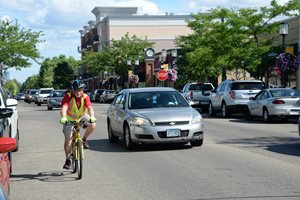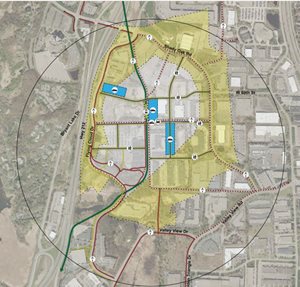 Most transit riders walk at some point to or from transit. Some transit riders connect by bicycle. For those that walk, most are walking no more than 10 minutes, about a ½-mile. Bicyclists may travel further. Willingness to walk or bike varies, influenced by the quality and frequency of transit as well as the quality and convenience of the connecting routes. Many, if not most, people may choose to walk no more than ½-mile to or from a transit stop.
Most transit riders walk at some point to or from transit. Some transit riders connect by bicycle. For those that walk, most are walking no more than 10 minutes, about a ½-mile. Bicyclists may travel further. Willingness to walk or bike varies, influenced by the quality and frequency of transit as well as the quality and convenience of the connecting routes. Many, if not most, people may choose to walk no more than ½-mile to or from a transit stop.
Walkshed and Bikeshed Analysis
Networks are interconnected systems of transportation routes. A walkshed or a bikeshed is a measure of the area that a network covers. Planners can use walkshed and bikeshed analysis to assess the adequacy of pedestrian and bicycle networks. For pedestrians, sidewalks and trails make up the pedestrian network. For bicyclists, the network may include roads with bicycle lanes, off-road facilities, or low-volume roadways where vehicles and bicyclists can safely share the roadway. The extent of both networks influences the desirability and practicality of using transit.
Station area planning typically includes an evaluation of walking conditions within a ½-mile radius from a station or stop. For bicycling, it can be as much as three miles. Planners identify the geographic area covered by actual distances using each network. Planners use this analysis to identify less accessible areas and what improvements might help.
 Evaluating Improvements
Evaluating Improvements
Potential improvements to pedestrian and bicycle networks should be evaluated by their feasibility and cost effectiveness. This analysis can be done using Geographic Information Systems (GIS). Results can support discussions with residents and businesses on the desirability, cost-effectiveness, and priority of improvements.
Improvements could be relatively small, and potentially cost-effective, such as completing sidewalks along an existing street. Other improvements might be more complicated, controversial, or costly, like building a pedestrian bridge or acquiring easements on private property. Some improvements might make redevelopment and employment locations more accessible. Some types of investments might benefit people who rely on transit the most.
Comprehensive Plans
Planned improvements to pedestrian and bicycle networks should be identified in station area plans and comprehensive plans. Plans should include principles related to an interconnected network. Plans should also explain how and when these principles will be applied, and they should be specific enough to identify the timing of improvements. Plans should specifically identify likely funding sources, such as general funds, state aid funds for local roads, dedications through land subdivision, and/or assessments.